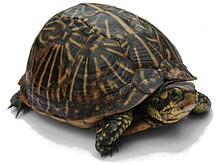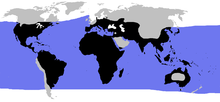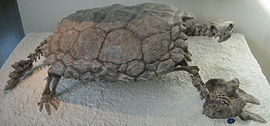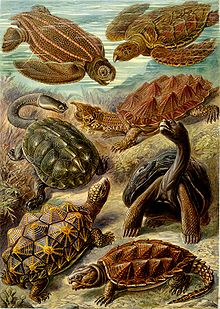Turtle
| Testudines | |
|---|---|

| |
| Florida box turtle (Terrapene carolina) | |
| Scientific classification | |
| Domain: | Eukaryota |
| Kingdom: | Animalia |
| Phylum: | Chordata |
| Class: | Reptilia |
| Clade: | Perichelydia |
| Order: | Testudines Batsch 1788 [2] |
| Subgroups | |
|
Cryptodira | |
| Diversity | |
| 14 living families with 356 species | |

| |
| Blue: sea turtles, black: land turtles | |
Turtles are one of the many reptiles on earth. They have a hard shell, which is useful for camouflage and protection from other animals.
There are two types of turtles: side-necked turtles and hidden neck turtles. Side-necked turtles have long necks, but hidden neck turtles have very small necks.
There are about 356 species of turtles living on land in all continents except Antarctica. They can live in both salt water and fresh water.
Testudines (which includes turtles) includes both living and extinct kinds. The earliest fossil of a turtle was found in China from the early Upper Triassic age. The fossil was from about 220 million years ago. Turtles are one of the oldest reptiles that are not extinct. Turtles have been on earth for longer than lizards, snakes and crocodiles. Turtles come from ancient turtles, which had spiked shells.
Turtles are almost everywhere in the world. A lot of the turtle species alive today are endangered.[3]
Names[change | change source]
Although the word turtle is widely used to describe all testudines, it is also common to see them called terrapins, tortoises or sea turtles. How these names are used depends on the type of English.
- British English calls them turtles if they live in the sea, or "terrapins" if they live in fresh water. They are called "tortoises" if they live on land.
- American English uses the word turtle for all kinds of turtles. "Tortoise" is used for most kinds living on land, and those living in the sea are usually called "sea turtles". "Terrapin" is not as commonly used.
- Australian English uses turtle for both the sea and freshwater kinds, but "tortoise" for those that live on land.[4]
To avoid confusion, the word "chelonian" is popular among some who work with these animals.[5] Unfortunately, Chelonia is also the name of a particular type of turtle, so this conflicts with "testudines".
Life[change | change source]
Although many turtles spend a lot of their lives underwater, all turtles and tortoises breathe air and must come to the surface to refill their lungs. Some spend their whole lives on dry land.
Aquatic respiration in Australian freshwater turtles is being studied. Some kinds of turtle have large cloacal holes that are lined with many finger-like things. These things, called papillae, have a lot of blood in them, and increase the surface area of the cloaca. The turtles get oxygen from the water using these papillae, in the same way that fish use gills.

Like other reptiles, turtles lay eggs which are slightly soft and leathery. The eggs of the largest kinds of turtle are shaped like spheres. Other turtles have eggs that are shaped more like chicken eggs. Sea turtles lay their eggs on dry, sandy beaches. Turtles can take many years to reach breeding age, and in many cases breed every few years rather than every year.
Some kinds of turtle have a sex determination that depends on temperature. This decides whether an egg develops into a male or a female. A higher temperature makes a female. A lower temperature makes a male. Large numbers of eggs are deposited in holes dug into mud or sand. They are then covered and left to incubate by themselves. When the turtles hatch, they go to the surface and head toward the water. No turtle mother cares for its young.
Long-lived[change | change source]
Researchers discovered that a turtle's organs do not get old over time. Unlike most other animals, they found that the liver, lungs, and kidneys of a century-old turtle are almost the same as those of a younger turtle. This has made genetic researchers begin studying turtle genetics for longevity genes.[6]
Body[change | change source]
Neck folding[change | change source]
Turtles are put into two groups from the way they hide their heads into their shells. The Cryptodira (hidden neck turtles) pull their heads straight into their shells by folding their necks back under their spines. They have very small necks. The Pleurodira (side-necked turtles), now found only in fresh water places in the Southern hemisphere, fold their necks to the side. The important adaptation of hiding their heads came from turtles in the past which were not able to do this. This adds to their defence against predators.
Feeding[change | change source]
Turtles have a hard beak. They use their jaws to cut and chew food. Turtles have hard edges called horny ridges that cover their upper and lower jaws. These ridges are different from teeth, which turtles do not have. Carnivorous turtles tend to have knife-sharp ridges that help them cut through meat. Herbivorous turtles have serrated-edged ridges that help them cut through tough plants. Turtles use their tongues to swallow food, but unlike most reptiles, they cannot stick out their tongues to catch food.
Shell[change | change source]
The upper shell of the turtle is called the carapace. The lower shell that covers the belly is called the plastron. The carapace and plastron are joined on the turtle's sides by bony structures called bridges.
The inside of a turtle's shell has about 60 bones. It includes parts of the spine and ribs, meaning the turtle cannot crawl out of its shell.
Largest living[change | change source]
The largest kind is a marine turtle called the great leatherback sea turtle. This can have a shell length of 200 cm (80 inches) and can weigh over 900 kg (2,000 lb, or 1 ton). Freshwater turtles tend to be smaller. The largest kind, the Asian giant softshell turtle Pelochelys cantorii, can be up to 200 cm or 80 in (Das, 1991). This is bigger than even the better-known alligator snapping turtle, the largest kind of turtle in North America. This can have a shell length of up to 80 cm (311⁄2 in) and a weight of about 60 kg (170 lb).
The largest fossil turtle, Archelon, was more than twice as long as the leatherback, at up to 4.5 metres.
Evolution[change | change source]


The earliest turtle fossils come from Upper Triassic of the Mesozoic era, about 220 million years ago.[7] Their shell came from bony extensions of their backbones and broad ribs that became larger and grew together to make a complete shell. This adaptation was very useful and has been around for a long time. It helped protect turtles as they evolved over many years, even when the bony part of the shell was not complete. The turtle family has survived many changes in the seas and several extinction events.
Fossils of the freshwater Odontochelys semitestacea or "half-shelled turtle with teeth", from the later Triassic, were found in southwest China. Odontochelys shows a complete bony plastron and an incomplete carapace. This is like baby turtles in embryonic development today.[8] By the Upper Jurassic, turtles had radiated widely, and their fossil history becomes easier to read.
We do not know exactly where turtles came from. Early amniotes had no openings in the skull behind the eyes. Holes started to appear in both Sauropsid and Synapsid skulls. They made the skull lighter, gave attachment points for muscles, and gave room for muscle bulges. But turtles do not have these holes in their skulls. They were called 'anapsids', meaning 'no openings'.
It may be that turtles came from sauropsids which had skull openings, but turtles lost these openings as they made heavy defensive armour.[9] All molecular studies show that turtles are diapsids; some think that turtles are either archosaurs,[10] or are a sister group to living archosaurs.[11][12][13][14][15]
The earliest known fully shelled turtles are the late Triassic Odontochelys, Chinlechelys and Proganochelys. The first-named genus was aquatic, but the second was probably terrestrial.[16] They already had many advanced turtle traits, and probably had millions of years of turtle evolution and species in their ancestry. They had a long neck and could not pull their heads into their shell. Odontochelys had a long, spiked tail ending in a club. Ankylosaurs also have similar things because of convergent evolution.
Related pages[change | change source]
References[change | change source]
- ↑ Li, Chun; Xiao-Chun Wu; Olivier Rieppel; Li-Ting Wang; Li-Jun Zhao (November 27, 2008). "An ancestral turtle from the Late Triassic of southwestern China". Nature. 456 (7221): 497–501. Bibcode:2008Natur.456..497L. doi:10.1038/nature07533. PMID 19037315. S2CID 4405644.
- ↑ Turtle Taxonomy Working Group (2017). Turtles of the World: Annotated Checklist and Atlas of Taxonomy, Synonymy, Distribution, and Conservation Status (8th Ed.) (PDF). Vol. 7. pp. 1–292. doi:10.3854/crm.7.checklist.atlas.v8.2017. ISBN 9781532350269.
{{cite book}}:|journal=ignored (help) - ↑ James E. Barzyk Turtles in crisis: the Asian food markets. The article itself is not dated, but mostly refers to data in the range 1995–2000.
- ↑ The word 'terrapin' is derived from the Algonquian word for this animal. "San Diego Zoo's animal bytes: turtle & tortoise". Archived from the original on August 5, 2012. Retrieved September 12, 2011.
- ↑ 'Chelonia' is based on the Ancient Greek word χελώνη, chelōnē; Modern Greek χελώνα, chelōna; meaning turtle/tortoise
- ↑ All but ageless: turtles face their biggest threat: humans
- ↑ Details are in Benton M. 2015. Vertebrate palaeontology. 4th ed, Oxford: Wiley Blackwell, p241–243.
- ↑ Li C. et al 2008. An ancestral turtle from the late Triassic of southwestern China (2008). "An ancestral turtle from the Late Triassic of southwestern China" (PDF). Nature. 456 (7221): 497–501. Bibcode:2008Natur.456..497L. doi:10.1038/nature07533. PMID 19037315. S2CID 4405644.
{{cite journal}}: CS1 maint: numeric names: authors list (link) - ↑ Rieppel O. & DeBraga M. 1996. Turtles as diapsid reptiles (1996). "Turtles as diapsid reptiles" (PDF). Nature. 384 (6608): 453–5. Bibcode:1996Natur.384..453R. doi:10.1038/384453a0. S2CID 4264378.
{{cite journal}}: CS1 maint: numeric names: authors list (link) - ↑ Mannena, Hideyuki & Li, Steven S. 1999. Molecular evidence for a clade of turtles (1999). "Molecular Evidence for a Clade of Turtles". Molecular Phylogenetics and Evolution. 13 (1): 144–148. doi:10.1006/mpev.1999.0640. PMID 10508547.
{{cite journal}}: CS1 maint: multiple names: authors list (link) CS1 maint: numeric names: authors list (link) - ↑ Zardoya R. & Meyer A. 1998. Complete mitochondrial genome suggests diapsid affinities of turtles (1998). "Complete mitochondrial genome suggests diapsid affinities of turtles". Proc Natl Acad Sci USA. 95 (24): 14226–14231. Bibcode:1998PNAS...9514226Z. doi:10.1073/pnas.95.24.14226. PMC 24355. PMID 9826682.
{{cite journal}}: CS1 maint: numeric names: authors list (link) - ↑ Iwabe N. et al 2004. Sister group relationship of turtles to the bird-crocodilian clade revealed by nuclear DNA-coded proteins (2005). "Sister Group Relationship of Turtles to the Bird-Crocodilian Clade Revealed by Nuclear DNA–Coded Proteins". Molecular Biology and Evolution. 22 (4): 810–813. doi:10.1093/molbev/msi075. PMID 15625185. Retrieved 2010-12-31.
{{cite journal}}: CS1 maint: numeric names: authors list (link) - ↑ Roos, Jonas; Aggarwal, Ramesh K. & Janke, Axel 2007 Extended mitogenomic phylogenetic analyses yield new insight into crocodylian evolution and their survival of the Cretaceous–Tertiary boundary (2007). "Extended mitogenomic phylogenetic analyses yield new insight into crocodylian evolution and their survival of the Cretaceous–Tertiary boundary". Molecular Phylogenetics and Evolution. 45 (2): 663–673. doi:10.1016/j.ympev.2007.06.018. PMID 17719245.
{{cite journal}}: CS1 maint: multiple names: authors list (link) CS1 maint: numeric names: authors list (link) - ↑ Katsu Y. et al 2010. From reptilian phylogenomics to reptilian genomes: analyses of c-Jun and DJ-1 proto-oncogenes (2009). "From Reptilian Phylogenomics to Reptilian Genomes: Analyses of c-Jun and DJ-1 Proto-Oncogenes". Cytogenetic and Genome Research. 127 (2–4): 79–93. doi:10.1159/000297715. PMID 20234127. S2CID 12116018.
{{cite journal}}: CS1 maint: numeric names: authors list (link) - ↑ Benton M J., Michael J. (2000). Vertebrate Paleontology (2nd ed.). London: Blackwell Science. ISBN 978-0-632-05614-9., 3rd ed. 2004 ISBN 978-0-632-05637-8
- ↑ Joyce W.G. et al. 2009. A thin-shelled reptile from the Late Triassic of North America and the origin of the turtle shell. Proc Biol Sci. 276(1656):507-13. PubMed A thin-shelled reptile from the Late Triassic of North America and the origin of the turtle shell. - PubMed - NCBI
